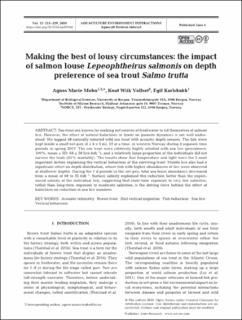| dc.contributor.author | Mohn, Agnes Marie | |
| dc.contributor.author | Vollset, Knut | |
| dc.contributor.author | Karlsbakk, Egil | |
| dc.date.accessioned | 2020-09-18T10:46:32Z | |
| dc.date.available | 2020-09-18T10:46:32Z | |
| dc.date.created | 2020-07-21T13:13:46Z | |
| dc.date.issued | 2020 | |
| dc.identifier.citation | Aquaculture Environment Interactions. 2020, 12 215-229. | |
| dc.identifier.issn | 1869-215X | |
| dc.identifier.uri | https://hdl.handle.net/11250/2678468 | |
| dc.description.abstract | ABSTRACT: Sea trout are known for seeking out sources of freshwater to rid themselves of salmon lice. However, the effect of natural haloclines in fjords on parasite dynamics is not well understood. We tagged 48 naturally infested wild sea trout with acoustic depth sensors. The fish were kept inside a small net-pen (4 × 4 × 5 m), 12 at a time, in western Norway during 4 separate time periods in spring 2017. The sea trout were relatively highly infested with sea lice (prevalence: 100%, mean ± SD: 68 ± 58 lice fish-1), and a relatively large proportion of the individuals did not survive the trials (25% mortality). The results show that temperature and light were the 2 most important factors explaining the vertical behaviour of the surviving trout. Mobile lice also had a significant effect on depth distribution, where fish with higher abundances of lice were observed at shallower depths. During the 7 d periods in the net-pen, total sea louse abundance decreased from a mean of 68 to 35 fish-1. Surface salinity explained this reduction better than the experienced salinity of the individual fish, suggesting that short-time exposure to very low salinities, rather than long-term exposure to moderate salinities, is the driving force behind the effect of haloclines on reduction in sea lice numbers. | |
| dc.language.iso | eng | |
| dc.rights | CC BY 4.0 | |
| dc.rights.uri | https://creativecommons.org/licenses/by/4.0/ | |
| dc.title | Making the best of lousy circumstances: The impact of salmon louse Lepeophtheirus salmonis on depth preference of sea trout Salmo trutta | |
| dc.type | Peer reviewed | |
| dc.type | Journal article | |
| dc.rights.holder | © 2020, Authors | |
| dc.description.version | publishedVersion | |
| cristin.ispublished | true | |
| cristin.fulltext | original | |
| cristin.qualitycode | 1 | |
| dc.identifier.doi | 10.3354/AEI00360 | |
| dc.identifier.cristin | 1820036 | |
| dc.source.journal | Aquaculture Environment Interactions | |
| dc.source.volume | 12 | |
| dc.source.pagenumber | 215-229 | |
| dc.relation.project | Norges forskningsråd: 243912 | |

